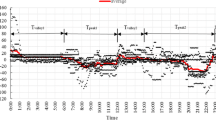Abstract
To fully explain hydropower unit operational problems, an optimal multi-objective dynamic scheduling model is presented which seeks to improve the efficiency of reservation regulation management. To reflect the actual hydropower engineering project environment, fuzzy random uncertainty and an integrated consideration of the natural resource constraints, such as load balance, system power balance, generation limits, turbine capacity, water head, discharge capacities, reservoir storage volumes, and water spillages, were included in the model. The aim of this research was to concurrently minimize discharges and maximize economic benefit. Subsequently, a new hybrid dynamic programming-based multi-start multi-objective simulated annealing algorithm was developed to solve the hydro unit operational problem. The proposed model and intelligent algorithm were then applied to the X Hydraulic and Hydropower Station in China. The computational unit commitment schedule results demonstrated the practicality and efficiency of this optimization method.





Similar content being viewed by others
References
Guan X, Svoboda A, Li C (1999) Scheduling hydro power systems with restricted operating zones and discharge ramping constraints. IEEE Trans Power Syst 14(1):126–131
Hreinsson EB (1988) Optimal short-term operation of a purely hydroelectric system. Trans Power Syst 3:1072–1077
Yakowitz S (1982) Dynamic programming applications in water resource. Water Resour Res 18(4):673–696
Cheng C, Liao S, Tang Z, Zhao M (2009) Comparison of particle swarm optimization and dynamic programming for large scale hydro unit load dispatch. Energy Convers Manag 50(12):3007–3014
Philpott AB, Craddock M, Waterer H (2000) Hydro-electric unit commitment subject to uncertain demand. Eur J Oper Res 125(2):410–424
Saber AY, Senjyu T, Miyagi T et al (2006) Fuzzy unit commitment scheduling using absolutely stochastic simulated annealing. IEEE Trans Power Syst 21(2):955–964
Su CC, Hsu YY (1991) Fuzzy dynamic programming: an application to unit commitment. IEEE Trans Power Syst 6(3):1231–1237
Saneifard S, Prasad NR, Smolleck HA (1997) A fuzzy logic approach to unit commitment. IEEE Trans Power Syst 12(2):988–995
Gang J, Xu J, The resource-constraint project scheduling with multi-mode under fuzzy random environment in the drainage engineering of LT hydropower. Int J Logist Transp Spec Issue Jt Semin Uncertain Decis Mak Eng Netw. 2010
Ma Y, Xu J (2014) Vehicle routing problem with multiple decision-makers for construction material transportation in a fuzzy random environment. Int J Civ Eng 12(2A):332–346
Zhang Z, Xu J (2013) A multi-mode resource-constrained project scheduling model with bi-random coefficients for drilling grouting construction project. Int J Civ Eng 11(1):1–13
Mok PY, Kwong CK, Wong WK (2007) Optimisation of fault-tolerant fabric-cutting schedules using genetic algorithms and fuzzy set theory. Eur J Oper Res 177(3):1876–1893
Balasubramanian J, Grossmann IE (2003) Scheduling optimization under uncertainty—an alternative approach. Comput Chem Eng 27(4):469–490
Goldratt EM (1997) Critical chain. The North River Press, Great Barrington
Xu J, Zhou Y (2011) Fuzzy-like multiple objective decision making [M]. Springer, Berlin
Zadeh LA (1965) Fuzzy sets. Inf Control 8(3):338–353
Shrestha BP, Duckstein L, Stakhiv EZ (1996) Fuzzy rule-based modeling of reservoir operation. J Water Resourc Plan Manag 122(4):262–269
Dubois D, Fargier H, Fortemps P (2003) Fuzzy scheduling: Modelling flexible constraints vs. coping with incomplete knowledge. Eur J Oper Res 147(2):231–252
Sowinski R, Hapke M (2000) Scheduling under fuzziness. Physica-Verlag, Heidelberg
Lootsma FA (1997) Fuzzy logic for planning and decision making. Kluwer Academic Publishers, London
Rani D, Moreira MM (2010) Simulation–optimization modeling: a survey and potential application in reservoir systems operation. Water Resour Manag 24(6):1107–1138
Sárfi RJ, Salama MMA, Chikhani AY (1996) Applications of fuzzy sets theory in power systems planning and operation: a critical review to assist in implementation. Electr Power Syst Res 39(2):89–101
Mousavi SJ, Ponnambalam K, Karray F (2005) A dynamic programming model coupled with fuzzy rule base for reservoir operation optimization. Int J Civ Eng 3(2):67–77
Mousavi SJ, Ponnambalam K, Karray F (2007) Inferring operating rules for reservoir operations using fuzzy regression and ANFIS. Fuzzy Sets Syst 158(10):1064–1082
Tarng YS, Ma SC, Chung LK (1995) Determination of optimal cutting parameters in wire electrical discharge machining. Int J Mach Tools Manuf 35(12):1693–1701
Ashtiani B, Aryanezhad MB, Moghaddam BF (2007) Multi-start simulated annealing for dynamic plant layout problem. J Ind Eng Int 3(4):44–50
de Oliveira HCB, Vasconcelos GC, Alvarenga GB (2006) Reducing traveled distance in the vehicle routing problem with time windows using a multi-start simulated annealing. In: Proceedings of the international joint conference on neural networks, 6, p 1
Koakutsu S, Hamagami T, Hirata H (2002) A multi-start simulated annealing using immunity-based operations and its application to the quadratic assignment problems. In: Proceeding: intelligent systems and control, p 366
Huang GH, Loucks DP (2000) An inexact two-stage stochastic programming model for water resources management under uncertainty. Civ Eng Syst 17(2):95–118
Xu J, Tu Y, Zeng Z (2012) Bilevel optimization of regional water resources allocation problem under fuzzy random environment. J Water Resourc Plan Manag 139(3):246–264
Pearson K (1895) Contributions to the mathematical theory of evolution, II: Skew variation in homogeneous material. Philos Trans R Soc Lond A:343–414
Kruse R, Meyer KD (1987) Statistics with vague data. Springer, Berlin
Heilpern S (1992) The expected value of a fuzzy number. Fuzzy Sets Syst 47(1):81–86
Adams J, Balas E, Zawack D (1988) The shifting bottleneck procedure for job shop scheduling. Manag Sci 34(3):391–401
Qin H, Zhou J, Lu Y, Wang Y, Zhang Y (2010) Multi-objective differential evolution with adaptive Cauchy mutation for short-term multi-objective optimal hydro-thermal scheduling. Energy Convers Manag 51(4):788–794
Liang R, Hsu Y (1995) A hybrid artificial neural network—differential dynamic programming approach for short-term hydro scheduling. Electr Power Syst Res 33(2):77–86
Allen RB, Bridgeman SG (1986) Dynamic programming in hydropower scheduling. J Water Resourc Plan Manag 112(3):339–353
Afshar MH, Ketabchi H, Rasa E (2006) Elitist continuous ant colony optimization algorithm: application to reservoir operation problems. Int J Civ Eng 4(4):274–285
Jalali MR, Afshar A, Mariño MA (2006) Multi-reservoir operation by adaptive pheromone re-initiated ant colony optimization algorithm. Int J Civ Eng 5(4):284–331
Kubotani H, Yoshimura K (2003) Performance evaluation of acceptance probability functions for multi-objective SA. Comput Oper Res 30(3):427–442
Bennage WA, Dhingra AK (1995) Single and multiobjective structural optimization in discrete-continuous variables using simulated annealing. Int J Numer Meth Eng 38(16):2753–2773
Kirkpatrick S, Gelatt CD, Vecchi MP (1983) Optimization by simulated annealing. Science 220(4598):671–680
Acknowledgments
The authors would like to thank the editors and anonymous referees for their useful comments and suggestions, which helped to improve this paper. This research is supported by the Key Program of National Natural Science Foundation of China (Grant No. 70831005), and also supported by “985” Program of Sichuan University “Innovative Research Base for Economic Development and Management”.
Author information
Authors and Affiliations
Corresponding author
Rights and permissions
About this article
Cite this article
Xu, J., Liu, Q. & Yang, Z. A Hybrid Optimal Model for Daily Reservoir Regulation Problem Under Fuzzy Random Environment. Int J Civ Eng 15, 35–49 (2017). https://doi.org/10.1007/s40999-016-0106-2
Received:
Revised:
Accepted:
Published:
Issue Date:
DOI: https://doi.org/10.1007/s40999-016-0106-2




